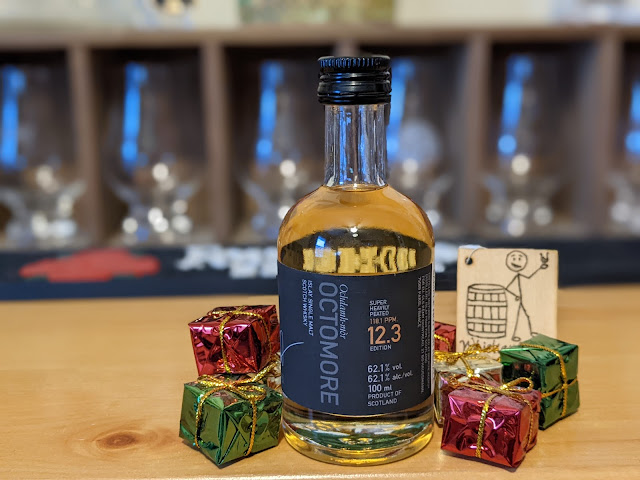Transparency is important. If there’s a possible conflict of interest, you need to know about it. For the last two years, I’ve been part of a group of influencers selected to launch Octomore to the US market. Last year, it was series 11, this year, series 12. Bruichladdich compensated me to write content for the release of each. It also provided me with samples of 12.1, 12.2, and 12.3. Bruichladdich tasked me with putting together tasting notes for 12.2. That left me with samples of 12.1 and 12.3 to review above and beyond my now-completed assignment. You can read my review of 12.1 here, and today I’m sipping 12.3, and this is my final review of 2021.
If
you’re curious about the numbering system, that’s pretty easy to explain. The
first number refers to the series release number. In this case, it is 12,
meaning the 12th release of Octomore. The other numbers are slightly
less indicative: x.1, x.2, x.3, and x.4. What do they mean?
- The first is the standard for the release, the core whisky, if you will. It always starts with 100% Scottish barley and is typically aged in first-fill Bourbon casks.
- The next, x.2, follows the same base as x.1 but is aged in some variation of European oak.
- The third, x.3, is a single vintage, single field, single malt expression. It is 100% Islay malted barley grown on the Octomore farm. They’re typically aged in a combination of American and European oak.
- The last, x.4, is released every other year and matures in virgin oak or a combination of virgin and vintage oak. When x.4 is off-year, it is replaced by Octomore 10-Year.
For the 12th edition, 12.3 starts with a 2014 harvested crop of concerto
barley from Church Field on Octomore farm, which was distilled in 2015. The PPM
of phenol is 118.1. The distillate aged in first-fill Bourbon casks (75%) and
first-fill Pedro Ximenez sherry butts.
Those
sherry butts are essential. In this case, they came from the Fernando de
Castilla bodega in Juarez. These are retired from its solera system, so you’re
getting a real sherry influence versus a sherry seasoned one.
“THE DNA OF THIS SPIRIT AND THE UNIQUE SOUL OF THIS WHISKY IS OPEN FOR ALL TO SEE. TO HEAR THE STORY AND TO TASTE THE WHISKY IS TO IMMERSE YOURSELF IN A SINGLE VINTAGE FROM A SINGLE HARVEST, RAISED IN ONE FIELD.” – Adam Hannett, Head Distiller
While
12.3 carries no age statement, it rested in its cooperage for five years. Once
dumped, the only thing added was a quick splash of Octomore spring water.
Nothing that would have even a negligible impact on proof. Octomore is
naturally-colored and non-chill filtered. Bottled at 62.1% ABV (124.2°), you
can expect to pay about $289.00 for a 750ml package. That is if you can find
it.
Appearance: Poured
neat in my Glencairn glass, this Scotch appeared as brilliant gold. It formed a
medium rim that created thick, speedy legs.
Nose: I let this whisky sit in the glass for about
15 minutes before I approached it. At that time, the air in my whiskey library
filled with sweet barbeque smoke. When I brought the glass to my face, I
smelled brine, lemon and orange peel, pineapple, apricot, and malt. As I drew
the aroma into my mouth, it was like a vanilla bomb exploded.
Palate: You’ve heard of Big Oil, right? Well, that pretty much describes the mouthfeel. It
was full-bodied for sure! The front of the palate featured citrus, pineapple,
honey barbeque sauce, and dry smoke. Following were brine, caramel, and malt. The
back offered flavors of English toffee, apple, pear, vanilla, and oak.
Finish: Here’s
where things really got interesting. The finish was dry and very long. Barbeque smoke, pimento wood, honey, citrus, caramel, and brine remained.
Bottle, Bar, or Bust: I say the finish was interesting because there were a lot of bold qualities competing with
one another, yet none overpowered. Instead, they were complimentary. Look, I’ve
been fascinated with the Octomore line, and 12.3 doesn’t disappoint. In fact, this one is my favorite between 12.1, 12.2, and 12.3. Is it worth the price? If you’re a fan of peat and of
Octomore, this is a slam-dunk Bottle. However, this may
be too big of a whisky at too high of a price for the casual drinker. Cheers!
My Simple, Easy to
Understand Rating System
- Bottle = Buy It
- Bar = Try It
- Bust = Leave It
Whiskeyfellow encourages
you to enjoy your whiskey as you see fit but begs you do so responsibly.

Comments
Post a Comment
As we should drink in moderation, all comments are subject to it. Cheers!